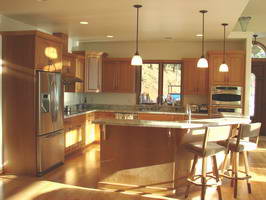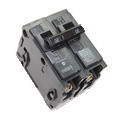Convert AC Power for a DC Inverter
 '; ';
|
Configuring Power for a 220 to 120 Converter for a DC Inverter System: If I use the converter, is 27 amps within the tolerance levels for using a 10 amp power tool, that needs 30 amps on start up. © By: Dave Rongey |
Converting 220 Volt to 120 Volt
Electrical Question: Here is my situation. I am on 40 ft sailboat in Lima Peru. The country has 220 volt, 3 wire circuits. My tools are all 110 volt so I need to find out how to get power while my boat is out of the water (I know a lot of this stuff will be out of code. SO I understand that these are HYPOTHETICAL Questions, so you will in no way be liable. BELIEVE ME, there is not much of a code here). I realize some of these questions deal are more on a electronics side of thing, but I would appreciate any input.
Project Background:
1) Checking the breaker box.
I have found that they have 2 cables (Red & Black) that are carrying 220 volts each. These are tied into double breakers. Originally they told me it was a 4 wire system, with two 110 volt legs. Now when I need the power this is not the case. All the voltage supplied to the box is 220 volts, 3 wire. This is at the box. When checking an outlet, and I connect my meter from one of the hot leads across to ground, and I get 274 volts, when I use the other hot lead I get 99 volts. This equals 273 volts, yet when I check the two prongs on the outlet I get 220 volt. I don’t get it.
2) Converters.
Looking locally at the converters I am only finding converters (very expensive) for 3000 VA (Va, I understand is equal to watts at low power usage). This gives me 27 available amps ( 3000 Va / 110 volts). Some of my tools require 10 amps, and on start up, I understand that I should have 3 times the amps or in this case 30 amps. So I am hesitant to use a converter because of possible damage to my tools.
3) Existing Converter/Inverter.
I have a combination system that I use in conjunction with shore power, and my batteries on the boat. On batteries, the unit inverts DC power to 110 AC. When plugged into 110 volt shore power, the unit transfers power to the AC Receptacles, and also charges the batteries. The unit will accept 220 volts coming in, but will only act as a battery charger. It will not convert the AC power, not will the inverter work. Also there is no transfer of power.
4) Required Power or Ideal Outcome.
I need to be able to both charge the batteries, and have 110 volt AC power, with enough amps for my tools.
Thanks in advance for you help Dave.
This electrical wiring question came from: Dave, in Lima Peru.
Thanks for your electrical question Dave.
Dave’s Answers to the Specific Questions:
Application: Convert AC Power for a DC Inverter.
Skill Level: Advanced. This electrical project is best performed by a Licensed Electrician.
Tools Required: Basic Electricians Pouch Hand Tools and a Voltage Tester.
Estimated Time: Depends on personal level experience, ability to work with tools.
Precaution: Identify the circuit, turn it OFF and Tag it with a Note before working with the wiring.
Notice: Installing additional electrical wiring should be done according to local and national electrical codes with a permit and be inspected.
Configuring Power for a 220 to 120 Converter for a DC Inverter System
Specific Electrical Questions and Answers:
1) Is there a way to get 110 volts out of 220 volt 3 wire system?
I can either come from the box, or the outlet. I can not find anything on the web that tells me if it is possible to rewire/change breakers, to get 110 volts from a 3 wire 220 volts system. Common sense tells me that I need to use a convert since the power supplied is 220 volts. The local electrician tells me that I can get one leg of 110 volts, but the amps will be halved. Do not understand this.
- Yes, but it is best if it were a 4-wire system (neutral and ground), but in a pinch the ground may be used if it is insulated and there is a good path to ground. Keep in mind the residual voltage that will be flowing to ground, typically the neutral.
- My concern is the different readings from the two legs of power, which is most likely due to their generating system.
- Keep in mind that a the traditional ground is only intended protect the equipment, and in cases of a GFCI it protects people, however it is never designed as a current carrying conductor.
2) If I use the converter, is 27 amps within the tolerance levels for using a 10 amp power tool, that needs 30 amps on start up.
- Like a generator, a converter must be sized to handle to maximum load, and that includes the starting load for motors. However some equipment will state that it will have a peak load threshold, or provision for a starting load or amps.
3) How to wire the converter?
The converter has 2 black wires going into it, and 2 black wires coming out. Do I need to worry about which are positive or negative on the incoming/outgoing legs?
- With 220/240 volt single phase power, with most equipment there is no problem with phasing or polarity, so it should not matter.
I am assuming that the converter is grounded somehow, and has fuse, circuit breaker or some type of overcurrent protection.
4) Can I use the converter to change the power into my inverter/combiner on my boat?
So if the converter comes in with 110 volt, pure sine, and 27 amps, and my combiner is rated to receive 30 amps, I am thinking that I can then use the electrical outlets on the boat to run power tools, and any deficiency in amps on start up, will be handled by the batteries.
- I have two concerns here:
1 – The converter would need to be designed to produce the pure sine wave, or as specified on your inverter/combiner. - 2 – If the converter looks OK, then I would consider using it only to charge the batteries and not run power tools at the same time. Keep in mind that the dynamics of the converter and the inverter will be greatly impacted when the load of the power tolls will occur, which could have unpredictable results.
However if the batteries are fully charged and your tools are within the specs of the inverter/combiner then there should be no problem, and if there was the system most likely has overcurrent protection. - Another thought is to use the converter directly for power tools, and while not using tools connect the converter to the inverter/combiner to charge the batteries, but not the two at the same time. My concern is the reliability of the converter.
- I don’t’ want anything to happen to your inverter/combiner.
5) Do converters going from 220 volts to 110 volts produce a pure sin curve?
- This would depend on the converter, and of course the quality of the input or primary power source.
More about Electrical Wiring
Wiring Electrical Outlets for the Home
Home electrical wiring includes 110 volt outlets and 220 volt outlets and receptacles which are common place in every home. See how wiring electrical outlets for the home are done.
Electrical Wire for Electrical Repairs and Home Remodel Projects
Electric Circuit Listing
The size of the home electrical service panel is designed by calculating the square footage of the home and factoring in the code requirements for the electrical circuits that are required.
Home Electrical Circuit Breakers
Home Electrical Circuit Breakers
A guide to home electrical circuit breakers and how they work to protect your electrical wiring. When properly installed, your home electrical wiring is protected by a circuit protection device.
Electrical Wire for the Home
Complete listing of electrical wire types and parts used for home projects with electrical code information serves as selection guidelines.
Wiring 220 Volt Electrical Outlet
Home electrical wiring includes 110 volt outlets and 220 volt outlets and receptacles which are common place in every home. See how electrical outlets for the home are wired.
Using Electrical Testers and Voltage Meters
Understanding Digital Volt Meters
When working on home electrical wiring using voltage meter can play an important part in electrical safety. Electrical testers and voltage meters enable you to identify electrical circuits and help prevent the possibility of accidental electrical shock.
The following may also be helpful for you:
|
|
Be Careful and Be Safe - Never Work on Energized Circuits!
Consult your Local Building Department about Permits and Inspections for all Electric Wiring Projects.
More articles about Electrical Wiring and Home Electrical Wiring: |
|
| « Previous | Next » |
Helping The Handyman with Four Way Switches |
How to Wire a Garbage Disposal and a Dishwasher Outlet |


















